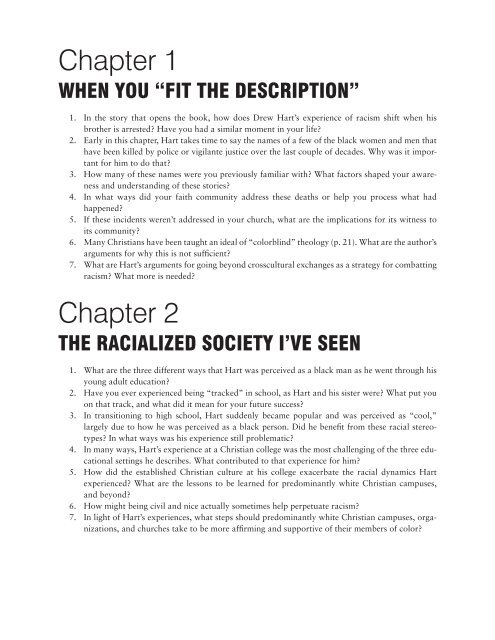Create successful ePaper yourself
Turn your PDF publications into a flip-book with our unique Google optimized e-Paper software.
Chapter 1<br />
When You “Fit the Description”<br />
1. In the story that opens the book, how does Drew Hart’s experience of racism shift when his<br />
brother is arrested? Have you had a similar moment in your life?<br />
2. Early in this chapter, Hart takes time to say the names of a few of the black women and men that<br />
have been killed <strong>by</strong> police or vigilante justice over the last couple of decades. Why was it important<br />
for him to do that?<br />
3. How many of these names were you previously familiar with? What factors shaped your awareness<br />
and understanding of these stories?<br />
4. In what ways did your faith community address these deaths or help you process what had<br />
happened?<br />
5. If these incidents weren’t addressed in your church, what are the implications for its witness to<br />
its community?<br />
6. Many Christians have been taught an ideal of “colorblind” theology (p. 21). What are the author’s<br />
arguments for why this is not sufficient?<br />
7. What are Hart’s arguments for going beyond crosscultural exchanges as a strategy for combatting<br />
racism? What more is needed?<br />
Chapter 2<br />
The Racialized Society I’ve Seen<br />
1. What are the three different ways that Hart was perceived as a black man as he went through his<br />
young adult education?<br />
2. Have you ever experienced being “tracked” in school, as Hart and his sister were? What put you<br />
on that track, and what did it mean for your future success?<br />
3. In transitioning to high school, Hart suddenly became popular and was perceived as “cool,”<br />
largely due to how he was perceived as a black person. Did he benefit from these racial stereotypes?<br />
In what ways was his experience still problematic?<br />
4. In many ways, Hart’s experience at a Christian college was the most challenging of the three educational<br />
settings he describes. What contributed to that experience for him?<br />
5. How did the established Christian culture at his college exacerbate the racial dynamics Hart<br />
experienced? What are the lessons to be learned for predominantly white Christian campuses,<br />
and beyond?<br />
6. How might being civil and nice actually sometimes help perpetuate racism?<br />
7. In light of Hart’s experiences, what steps should predominantly white Christian campuses, organizations,<br />
and churches take to be more affirming and supportive of their members of color?


